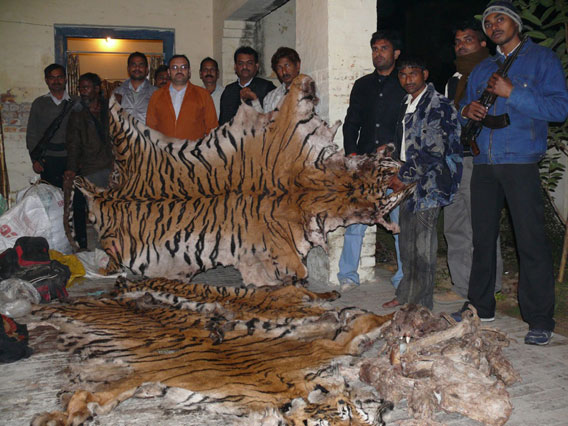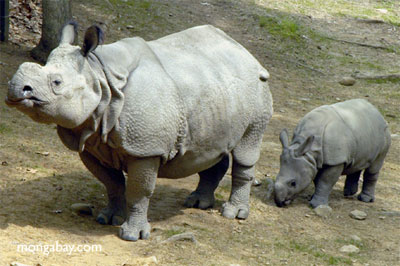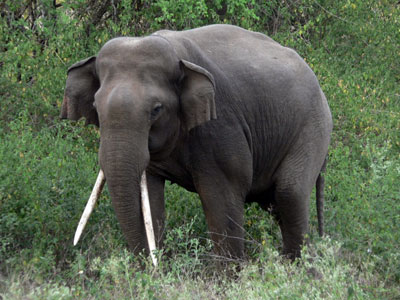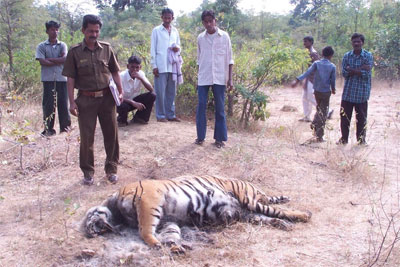An Interview with Belinda Wright, Founder & Executive Director of the Wildlife Protection Society of India (www.wpsi-india.org)
Over the past 100 years wild tiger numbers have declined 97% worldwide. In India, where there are 39 tiger reserves and 663 protected areas, there may be only 1,400 wild tigers left, according to a 2008 census, and possibly as few as 800, according to estimates by some experts. Illegal poaching remains the primary cause of the tiger’s decline, driven by black market demand for tiger skins, bones and organs. For example, so far in May, four big cats have died in the Corbett Tiger Reserve alone due to poaching and poisoning.
This precipitous fall in tiger populations in India has lead the government to take crucial if not radical steps to prevent the Bengal Tiger from going extinct. Not only are poaching, illegal logging, and habitat loss now being addressed, but the mushrooming tourism trade in and around tiger reserves will most likely be curtailed in the near future, as well.
- 832 tigers known to have been killed in India from 1994 to 2007
- 21 tiger deaths so far in 2010, 10 from natural causes, 11 from poaching
- $5,000 Price paid by traders to poachers for a complete dead tiger
- $50,000 Price paid for a complete tiger at market
- $35,000 Price paid for a tiger skin at market
 Tiger in Kanha Tiger Reserve. Photo © Belinda Wright, WPSI. |
Tiger facts
One of India’s leading conservationists, Belinda Wright has been on the forefront of the country’s wildlife issues for over three decades. While her organization, the Wildlife Protection Society of India (WPSI ), does not carry the global recognition of large international NGOs, her group’s commitment to the preservation of tigers, their habitat, and the Indian people who live with these apex predators, is one reason tigers still exist.
In May 2010, Wright spoke with mongabay.com about her in-the-trenches effort to protect tigers and India’s endangered wildlife populations.
AN INTERVIEW WITH BELINDA WRIGHT
Mongabay: Your family has a long and distinguished history in humanitarian and conservation efforts in India. What made you decide that wildlife, and tigers especially, are your calling?
 Belinda in Orissa, March 2010. Photo © WPSI. |
Belinda Wright:
Both my parents were wildlife enthusiasts. I spent much of my childhood in the jungles of eastern India, in tiger habitat in fact, and I guess it was in my blood. I never wanted to do anything else and I remember, at the age of 14, announcing this to my family. A few years later I ventured out as a wildlife photographer – a rare creature in those days – and later became a wildlife documentary film maker. I worked for many years, both as a still photographer and a filmmaker, for National Geographic. Then in 1994, I made the decision to become a full-time wildlife activist and put away my cameras. I guess it was pay-back time, for all that wildlife had given me. I have now been working on wildlife issues in India for over 35 years.
Umbrella species like the tiger and Asian elephant are under tremendous pressure from poaching, habitat loss, and human population growth. How does WPSI’s work address these issues? Which programs are you seeing making the biggest impact?
WPSI has been working tirelessly for more than 15 years to tackle India’s growing wildlife crisis by providing support and information to government authorities to combat poaching and illegal wildlife trade; by dealing with human-animal conflicts; and by providing support to conservation field projects.
 Belinda Wright and Baiga tribals. Photo © Belinda Wright / WPSI. |
Our Anti-Poaching and Illegal Wildife Trade program has been particularly successful. A countrywide network of WPSI field investigators provides a constant flow of information that is processed and used to assist enforcement authorities in the arrest of hundreds of wildlife criminals throughout India, and the seizure of wildlife products, particularly tiger parts. WPSI also maintains a Wildlife Crime Database which has records of more than 16,500 wildlife cases, along with details of over 12,900 alleged wildlife criminals. It is continuously updated and plays a critical role in exposing the extent of poaching and trade in India. It also plays an important part in the development of new conservation strategies.
We also conduct Wildlife Law Enforcement Workshops. So far, we have hosted nearly 190 workshops and provided training to more than 7,800 forest and police officers in 17 states across India. We have given specialist presentations to institutions such as the National Police Academy, the Indian Institute of Criminology, the Central Bureau of Investigation (CBI), the Indo-Tibetan Border Police (ITBP), Customs and Excise, the Wildlife Institute of India, and various enforcement training centers.
 Seizure of 3 tiger skins and 3 skeletons in Allahabad in December 2007. Photo © Belinda Wright / WPSI. |
WPSI’s Legal Program aims at strengthening wildlife laws and their implementation through research and advocacy. At the policy level, WPSI engages and interacts with Government ministries and departments, and at the ground level we support the prosecution of poaching and trade cases that involve the tiger and other endangered species. We also file petitions on important wildlife conservation issues, including encroachments in protected areas.
Apart from curbing wildlife crime, our other priority areas include critical issues such as the growing human-animal conflict (which in turn fuels poaching), and awareness generation. We support conservation projects on subjects as varied as elephant corridors, tiger census techniques and a campaign to save the olive ridley sea turtle off the coast of Orissa. One such high-impact project is our “Corridor to Survival” landscape plan for elephants in the states of Jharkhand and Orissa, in eastern India. An action plan for elephant conservation has been drawn up by WPSI which is currently being implemented by the Orissa State Government.
WPSI has site-specific projects in and around six Tiger Reserves – Sundarban, Ranthambhore, Bandhavgarh, Tadoba, Corbett and Satkosia Gorge.
Mongabay: I have been asked before how can one worry about wildlife and donate to conservation with so many humanitarian crises taking place. I respond by pointing out that it isn’t the animals that receive the money – it’s the people who live with them. Do you see WPSI’s role as not only conservation driven, but humanitarian driven as well?
Belinda Wright:
Although WPSI’s main activities are targeted towards wildlife, we believe that there is a vital link with humanitarian issues. In our experience, for conservation efforts to succeed local people need to become stakeholders, economically and emotionally.
 Belinda in the Sundarbans in 2008. Photo © WPSI. |
Our on-ground projects reflect this. We always hire local staff, and endeavor to create income-generating activities among the local communities to reduce pressure on the forests and wildlife. Through our Community Outreach Program in the Sundarbans, for instance, we have supported the development of a range of livelihood activities to help reduce people’s dependency on the forests.
WPSI has supported a micro credit scheme for over 50 self-help groups of women in the Sundarbans. These women are now earning incomes for their families by running mangrove plantation nurseries, and also by embroidering tigers and other animals onto silk, which are made into cushions for sale in the cities. WPSI also provides healthcare and education facilities to the local people, to help them become more aware of the benefits and responsibilities towards their forests and wildlife. Over the years, this has helped reduce the animosity against wildlife and man-animal conflict in the area.
Mongabay: What has been the overall effect on these local communities where this conservation/humanitarian work is being done?
 Kindergarten school in the Sundarbans. Photo © WPSI. |
Belinda Wright:
It is really heartening to see that where we have been able to effectively combine conservation and humanitarian activities, the local communities have started to view their wildlife as an asset rather than as a threat. The understanding that they cannot survive without their forests is palpable, and some people have even begun to undertake their own conservation activities.
In the Sundarbans, over 180,000 mangrove saplings have been planted in and around Bali Island by the local communities. With our support, the locals have also formed a voluntary Tiger Rescue Team which reacts swiftly to any reports of tigers entering nearby villages. Armed with nets, sticks and portable loudspeakers, they assist in keeping crowds away from a tiger until the Forest Department arrives on the scene. This has helped save many tigers from a violent and unnecessary death.
Chinese demand for tiger parts has been the tiger’s nemesis for many decades now. WPSI works closely with the Indian government to curtail poaching and trade in illegal wildlife, but each year goes by and wildlife numbers continue to fall. What do you see is necessary for a real break through – a systematic end of poaching as we know it?
 Belinda with tiger and leopard bone seizure in central India in 1995. Photo © WPSI. |
One of India’s biggest challenges, particularly to safeguard wild tigers, is the enforcement of our wildlife laws. Although we have good wildlife laws and policies, they are not implemented effectively. Enforcement has also not moved with the times. What we need now is professional, intelligence-led enforcement. Without this we cannot hope to stop the poaching mafias that empty our forests often with impunity, and the well-organized traders and smugglers that control the trade in tiger and other wildlife parts across international borders.
India has been trying to dialogue with China, where the lucrative and huge demand for tiger parts is fueled. Until this has been achieved, and China agrees to keep its 1983 ban on the use of tiger bone in traditional Chinese medicine in place and seriously crack down on the trade in tiger parts, the best thing India can do is to focus on keeping our wild tigers alive.
The effective implementation of our wildlife laws, to stop poaching of tigers and their prey species, will go a long way to achieving this. We must also deal with three other critical issues of habitat loss, man-animal conflict, and good leadership in the field. There is now a lot more awareness of these problems and the Indian Government is providing the funds and taking big steps to address these issues.
Mongabay: Given the downturn in the global economy, have you seen any variations in poaching numbers this past year?
Belinda Wright:
The number of tiger poaching cases does not seem to be effected by the downturn in the global economy. In fact, 2010 is the ‘Year of the Tiger’ in China, and poaching cases are predicted to be higher than usual to feed the demand for tiger parts.
In 2009, WPSI recorded 85 cases of tiger mortality, which included 32 poaching and seizure cases (38%). So far in 2010, we have already lost 23 wild tigers, including 15 tigers to poaching.
Mongabay: Aside from tigers, how are other indicator species like the Great Indian One-horned Rhinoceros doing?
 Captive indian rhino with baby (horns have been removed for protection). Photo by Rhett Butler.  Indian elephant in Bandipur Tiger Reserve. Photo © Belinda Wright / WPSI. |
Belinda Wright:
Although the Great Indian One-horned Rhinoceros made a spectacular comeback in the 1900s, it is now facing two serious threats, that of poaching and loss of habitat to encroachments. Rhino horns are highly valued in the illegal wildlife trade. They are also known to help fund the activities of insurgents, including the purchase of arms, in north-east India.
Kaziranga National Park, which is only 430 sq km, is home to about 2,048 Indian rhinos (68% of the world’s population). Not a week goes by when the brave forest guards of Kaziranga have a shoot out with poachers. Even the army has been called in to help with the battle against poachers. At least nine rhinos have been killed by poachers in Kaziranga in the first five months of 2010.
Mongabay: No doubt you had many encounters with tigers during the making of your Emmy Award-winning National Geographic film “Land of the Tiger.” Is there any one particular “tiger moment” that moves you even today?
Belinda Wright:
I have two “tiger moments” that are deeply etched in my memory; even now they continue to inspire me to fight on to secure a future for wild tigers.
The first, was one afternoon in Kanha National Park in 1982. I was sitting on the back of an elephant watching a tigress we called ‘Banseri’ in a bamboo forest. Banseri moved towards a clearing ablaze with shafts of golden light. She laid down, lifted her head and made a gentle call. Two young cubs padded out of the bamboo, greeted her affectionately and startled suckling. This is the first time I had ever seen this and I have never felt more privileged.
 Belinda at a wildlife enforcement workshop in central India, Oct 2009. Photo © WPSI. |
The second moment was early one morning in Ranthambhore, also in 1982, when I was sitting quietly in a stripped-down Jeep watching a tigress we knew well called ‘Lakshmi’. She was in a rocky stream-bed and had just killed a cheetal stag. After a while, Lakshmi looked up at us and with considerable difficulty lifted the dead cheetal and carried it determinedly towards our parked Jeep. She stuffed her prize virtually under the vehicle and looked at us as if to say ‘please look after this for me’. She then walked to a nearby pool to drink and cool off. Fifteen minutes later Lakshmi returned, pulled the stag out, and proceeded to eat it beside us. If was an incredible example of trust by a wild carnivore.
Mongabay: What is your current estimation of the wild tiger population and if things improve, where do you think this number could be in 5 or 10 years?
 Tiger electrocuted near Chandrapur. Photo © WPSI. |
Belinda Wright:
I believe the last all-India tiger estimation, which gave a lower limit of 1,165 tigers and an upper limit of 1,657 (this did not include tigers in Sundarban, Jharkand and parts of Chhattisgarh), was as accurate as possible. These depressing figures were released in 2008, after two years of research. Tiger poaching and mortality figures have certainly not decreased since then and unfortunately it is likely that the new estimation will show a further decline in tiger numbers. The results of the study are due to be released in October 2010.
But all hope is not lost for the tiger. Tigers are resilient, and good breeders. If we can secure their protection, good prey densities and inviolate space for these incredible big cats, India can certainly sustain a much larger tiger population.
Mongabay: What can the general public outside of India do to get involved with tiger conservation?
Belinda Wright:
The most effective thing that people outside India can do is to speak out about wild tigers, and show that they care about their survival. India, and the other 14 tiger range countries, need to know that this is a critical issue and that the eyes of the world are watching them.
China, in particular, needs to understand that saving wild tigers is an important global issue and that it is imperative that China takes five urgent steps: (i) publicly declare that the 1993 ban on the use of tiger bones for traditional Chinese medicine is permanent, (ii) destroy all its stockpiles of tiger parts, as India has done, (iii) phase out tiger farms, (iv) send a strong message to consumers that the use of skins and other tiger parts will not be tolerated, and (v) enforce the law.
 Tiger in Bandhavgarh Tiger Reserve. Photo © Belinda Wright / WPSI. |
People outside India need to keep themselves informed of the issues surrounding the plight of the tiger. They can do this by following stories in the media, and on the internet, and by following current conservation efforts. The website truthabouttigers.org and WPSI’s website www.wpsi-india.org are two such informative websites. People outside India should also keep their governments and public aware of the issues by writing letters to political leaders, newspaper editors, etc.
Another way of helping is to donate funds for tiger conservation efforts in India, or start a fund raising campaign in your school, work environment, or community.
You do not have to be in India to be a part of the tiger conservation movement. Everyone has a skill to offer, either in person or through the Internet, that can contribute to the cause; journalists can spread awareness, people with IT skills can assist with websites, politicians can make sure that the issue is kept alive politically, and others in civil society can raise funds and awareness.
It is essential that we all work together to save what is undoubtedly the most charismatic animal on this planet. If we fail, the world will be a much, much poorer place, and indeed future generations will condemn us for letting this glorious animal, the tiger, slip through our fingers.
Wildlife Protection Society of India
Video interviews
Art Wolfe Bengal Tigers of Northern India, BW interview, April 2009
Explore, BW interview, June 2007
Elephant Family Asian elephant conservation, BW interview, April 2010
BBC, Panna excerpt from ‘Battle to Save the Tiger’, Oct 2008
BBC, Sariska excerpt from ‘Battle to Save the Tiger’, Oct 2008
BBC, excerpt from ‘Battle to Save the Tiger’, David Attenborough on future of tigers, Oct 2008
Related articles
Banning Tiger Tourism in India: a perspective

(05/05/2010) A debate rages in India over a proposal to ban tiger tourism in India. Proponents of the ban say tiger tourism is intrusive and disturbs tigers and wildlife in tiger reserves. Opponents say that among all the threats to the tiger, tourism is the least potent and raises awareness. Shubhobroto Ghosh of TRAFFIC India weighs in on the issue after seeing his first wild tiger in the flesh.
The Critically Endangered South China Tiger Roars Again in 2010, the Chinese Year of the Tiger

(02/14/2010) Today marks the Chinese New Year for 2010, and the start of the traditional Year of the Tiger. The people of China might be celebrating future Years of the Tigers without their native and critically endangered South China Tiger (Panthera tigris amoyensis) if not for the efforts of Save China’s Tigers (SCT) a grassroots conservation effort headed by the charismatic Li Quan and her husband Stuart Bray. Both Ms Quan and Mr. Bray are former senior executives in international business circles. After leaving the corporate world, Ms Quan and Mr. Bray are now stepping up as champions for China’s natural environment, much of which has been lost in the Chinese march towards “The Four Modernizations.”
India to track every tiger death on-line
(02/07/2010) Due to increased problems with poaching, the conservation organization TRAFFIC has joined with the National Tiger Conservation Authority (NTCA) to begin tracking every tiger mortality in India with a new website called Tigernet.
Why top predators matter: an in-depth look at new research
(02/02/2010) Few species have faced such vitriolic hatred from humans as the world’s top predators. Considered by many as pests—often as dangerous—they have been gunned down, poisoned, speared, ‘finned’, and decimated across their habitats. Even where large areas of habitat are protected, the one thing that is often missing are top predators. However, new research over the past few decades is showing just how vital these predators are to ecosystems. Biologists have long known that predators control populations of prey animals, but new studies show that they may do much more. From controlling smaller predators to protecting river banks from erosion to providing nutrient hotspots, it appears that top predators are indispensible to a working ecosystem. Top predators sit at the apex of an ecosystem’s food chain. Wolves in Alaska, tigers in Siberia, lions in Kenya, white sharks in the Pacific are all examples of top predators.
